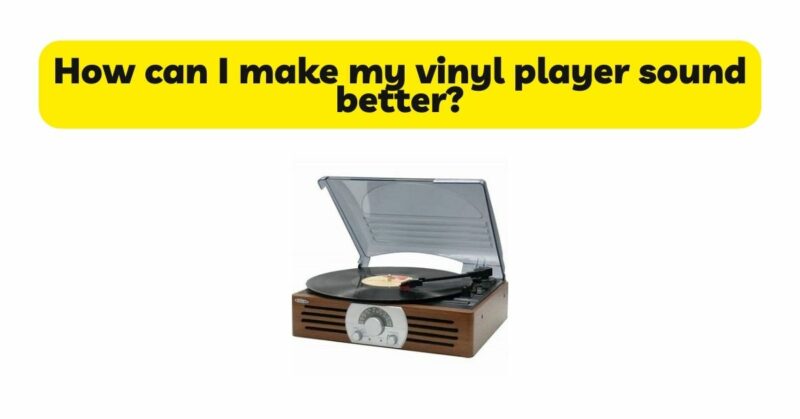Owning a vinyl player provides a unique and immersive listening experience, but there are steps you can take to make it sound even better. By optimizing various aspects of your setup, you can enhance the sound quality and maximize your enjoyment of vinyl records. In this article, we will explore practical tips and techniques to help you make your vinyl player sound better, covering areas such as turntable setup, cartridge selection, record care, playback equipment, and room acoustics. By implementing these suggestions, you can elevate the performance of your vinyl player and indulge in a more immersive and satisfying audio experience.
- Turntable Setup: a. Balance the tonearm: Properly balancing the tonearm ensures optimal tracking and reduces unnecessary wear on the stylus. Use a tonearm balance or scale to achieve perfect balance according to the manufacturer’s instructions.
b. Set tracking force and anti-skate: Adjusting the tracking force and anti-skate settings to the manufacturer’s recommended values helps maintain accurate tracking, minimizing distortion and wear on the stylus. Use a digital scale or tracking force gauge for precise adjustment.
c. Ensure proper cartridge alignment: Accurate alignment of the cartridge ensures optimal tracking across the record grooves. Utilize alignment tools or seek professional assistance to achieve the correct alignment, minimizing distortion and improving audio fidelity.
- Cartridge Selection: Choosing the right cartridge can significantly impact sound quality. Consider factors such as stylus type (elliptical, microline, etc.), compliance, and output level. Research and explore different cartridge options to find one that suits your musical preferences and provides enhanced sound reproduction.
- Record Care: Proper care of your vinyl records is essential for optimal sound quality and longevity. Follow these steps to ensure the best possible playback:
a. Cleaning: Regularly clean your records using a carbon fiber brush or record cleaning solution to remove dust, debris, and static buildup. For deeper cleaning, consider using a record cleaning machine.
b. Storage: Store your records vertically in protective inner sleeves and outer jackets to prevent dust accumulation, scratches, and warping. Keep them in a controlled environment with moderate temperature and humidity levels.
c. Handling: Handle records by their edges and avoid touching the playing surface to minimize fingerprints and smudges. Use a record clamp or weight to improve stability during playback.
- Playback Equipment: a. Phono Preamp: Ensure you have a quality phono preamp to amplify the low-level signal from your turntable. Look for models with low noise and accurate RIAA equalization to preserve the original sound quality.
b. Amplification: Invest in a good-quality amplifier or receiver to drive your speakers effectively. Choose an amplifier that complements your speakers and provides clean and dynamic sound reproduction.
c. Speakers: Consider investing in high-quality speakers that are well-suited to your listening space. Look for speakers with a balanced frequency response, good imaging capabilities, and adequate power handling.
d. Interconnects and Cables: Opt for high-quality interconnects and cables to ensure proper signal transfer and minimize interference. Consider shielded cables and gold-plated connectors for better signal integrity.
- Room Acoustics: Improving the acoustics of your listening room can significantly enhance the sound quality of your vinyl player. Consider the following:
a. Speaker Placement: Experiment with speaker placement to achieve proper stereo imaging and soundstage. Avoid placing speakers too close to walls or corners, as it can cause unwanted reflections and bass buildup.
b. Acoustic Treatments: Add acoustic treatments such as absorptive panels, diffusers, or bass traps to reduce echo, flutter echoes, and standing waves. These treatments improve sound clarity and overall balance.
c. Room Layout: Optimize your listening position and the placement of furniture to minimize unwanted reflections and optimize the sound propagation in the room.
- Environmental Considerations: Maintaining suitable environmental conditions can impact the performance of your vinyl player. Aim for moderate temperature and humidity levels to prevent warping or damage to your records and equipment. Avoid exposing your turntable to direct sunlight or extreme temperature fluctuations.
- Continuous Exploration: Keep an open mind and continuously explore new music genres, artists, and record releases. Experiment with different vinyl pressings, mastering techniques, and musical styles to discover the full potential of your vinyl player and expand your musical horizons.
Conclusion: By implementing these tips and techniques, you can significantly improve the sound quality of your vinyl player. From fine-tuning the turntable setup to selecting the right cartridge, caring for your records, investing in quality playback equipment, optimizing room acoustics, and considering environmental factors, these steps will help you achieve a more immersive and satisfying vinyl listening experience. Remember that the journey to better sound quality is an ongoing process, so keep exploring, experimenting, and fine-tuning your setup to unlock the full potential of your vinyl player. Enjoy the rich and captivating sound that vinyl records have to offer.


